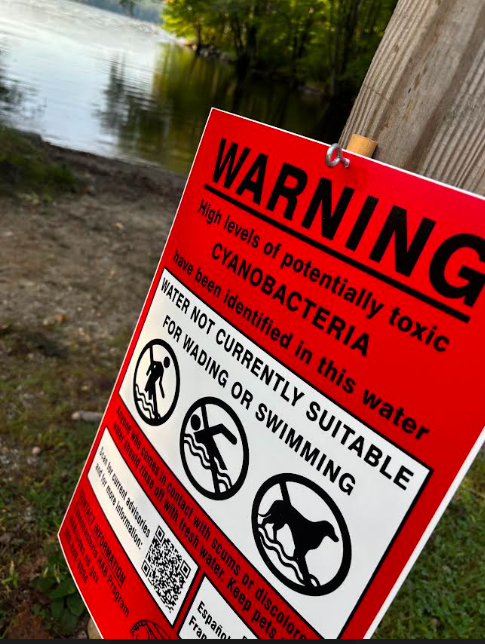Check the DES web page here for updates: https://www.arcgis.com/apps/dashboards/8d84a6b03acb4efaab571b222c78447b
Cyanobacteria blooms can be harmful to pets, livestock, wildlife and people. For more information about human health effects of harmful algal blooms, visit the U.S. Environmental Protection Agency website.
By PAULA TRACY, InDepthNH.org
HOLDERNESS – Just days after the White Oak Pond Watershed Association filed a $100,000 grant application with the state to create a watershed management plan for the 298-acre water body, the red warning sign went up Monday warning of cyanobacteria.
Green ribbons of material were found floating at the canoe and kayak put-in near the dam at the north end of White Oak Pond, which flows into Big Squam Lake’s Piper Cove.
The last time Big Squam had a bloom of cyanobacteria was in 2018 in Piper Cove and that summer White Oak Pond had warnings up for five days. Since then it had warnings issued for 19 days in 2020, and 32 days in 2022.
According to state officials the form of cyanobacteria confirmed in White Oak Pond is microcystis, which has been the same form seen in the past.
“We knew it was coming, thanks to collaborating with the Squam Lakes Association,” said Nancy Isikoff, president of the White Oak Pond Watershed Association.
The board of WOPWA voted unanimously Aug. 24 to spend $25,000 on a watershed management plan and apply for the state match through the 604(b) grant application process.
Cole Beale, director of conservation for the SLA, wrote to WOPWA that on Aug. 21 in the deepest part of the pond where they had been monitoring water quality, signs that a bloom could occur were present and he warned the association of the probability of a recurrence.
Isikoff said Tuesday that the association has received a scope of work and cost estimate of $100,000 from FB Environmental Association to analyze site specific issues ranging from septic system care to water quality monitoring, create a build out plan for what it would look like if every shorefront parcel was developed and an action plan with the goal of substantially reducing such future occurrences.
Most of the west and southern shore of White Oak Pond is undeveloped or in conservation, she noted.
The application for the grant for a water management plan includes letters of support from the Town of Holderness Select Board, its Conservation Commission, the Squam Lakes Conservation Society, the SLA and the White Oak Pond Watershed Association.
The State administers the 604(b) grant program using federal US Environmental Protection Agency Clean Water Act funds and this year, about $180,000 is available with priority given to high potential impact areas. A link to the application information and who can apply is here https://www.des.nh.gov/sites/g/files/ehbemt341/files/documents/604b-information-packet-2025.pdf
Currently all areas of Lake Winnipesaukee either have a watershed management plan or ones are in the process of being completed.
The Squam Lakes have a watershed plan and one was recently completed on Lake Kanasatka in Moultonborough, which has had chronic cyanobacteria problems in the past.
OTHER STATE WATER BODIES WITH CURRENT CYANOBACTERIA WATCHES AND WARNINGS
DES has current cyanobacteria watches or alerts still up for Lake Winnipesaukee in the Alton Area (issued on 8/19/2024) the Tuftonboro Area (issued on 8/27/2024), the Wolfeboro Area (issued on 9/5/2024), The Broads (issued on 9/5/2024) and Governor’s Island Area (issued on 9/5/2024).
Also watches are in effect for French Pond, in Henniker (issued on 9/4/2024), Pool Pond, in Rindge (issued on 9/12/2024), Province Lake, in Effingham and Wakefield (issued on 9/13/2024) Arlington Mill Reservoir in Salem (issued on 9/13/24), Jenness Pond in Northwood (issued on 9/13/2024), Duncan Lake in Ossipee (issued on 9/13/2024), Bow Lake in Strafford (issued on 9/13/2024), Webster Lake in Franklin (issued on 9/16/2024), and Lake Wentworth in Wolfeboro (issued on 9/16/2024
According to the state, White Oak Pond was joined by Sunrise Lake in Middleton this week on the state’s warning list for cyanobacteria.
Sunrise Lake had seen similar problems in the summer of 2023 but a different form of cyanobacteria than White Oak Pond.
Lake Ivanhoe in Wakefield also has a warning that went up on Sept. 9 with clumps of dark green material and cloudy water.
Other current cyanobacteria warnings in which public health risks are currently found include Emerson Pond in Rindge (issued on 8/29/2024), Warren Lake in Alstead (issued on 9/4/2024)
Lake Monomonac in Rindge (issued on 9/5/2024), Locke Lake in Barnstead (issued on 9/11/2024), Shaws Pond, in New Durham (issued on 9/12/2024), Baptist Pond, in Springfield (issued on 9/13/2024), and Tucker Pond in Salisbury (issued on 9/13/2024).
There are no current fecal bacteria advisories in the state the DES reports.
THIS IS SEPTIC SMART WEEK
The New Hampshire Lakes Association issued a press release this week, noting that this is Septic Smart Week. It said problems with septic systems is a factor in the development of toxic cyanobacteria blooms.
“Problems with septic systems can lead to nutrients and bacteria seeping into groundwater and finding their way into our lakes, causing potentially toxic cyanobacteria blooms. And no one wants their septic system backing up! Properly maintaining your septic system is crucial for your home and healthy lakes,” it reads.
An inspection by a licensed professional can uncover issues and should be done every three years, NH Lakes said. It also asked property owners to plant only non woody, shallow rooted plants on a leach field and mow at least once a year, practice water conservation, rent a portapotty for large events, space out laundry and dish loads, use low flow plumbing fixtures and compost.
It said property owners should not wait until something goes wrong, don’t flush anything but toilet paper, don’t add excessive weight to the top of your system and don’t put chemicals, fats, paint, deodorizers, septic additives or other waste down the drain.





